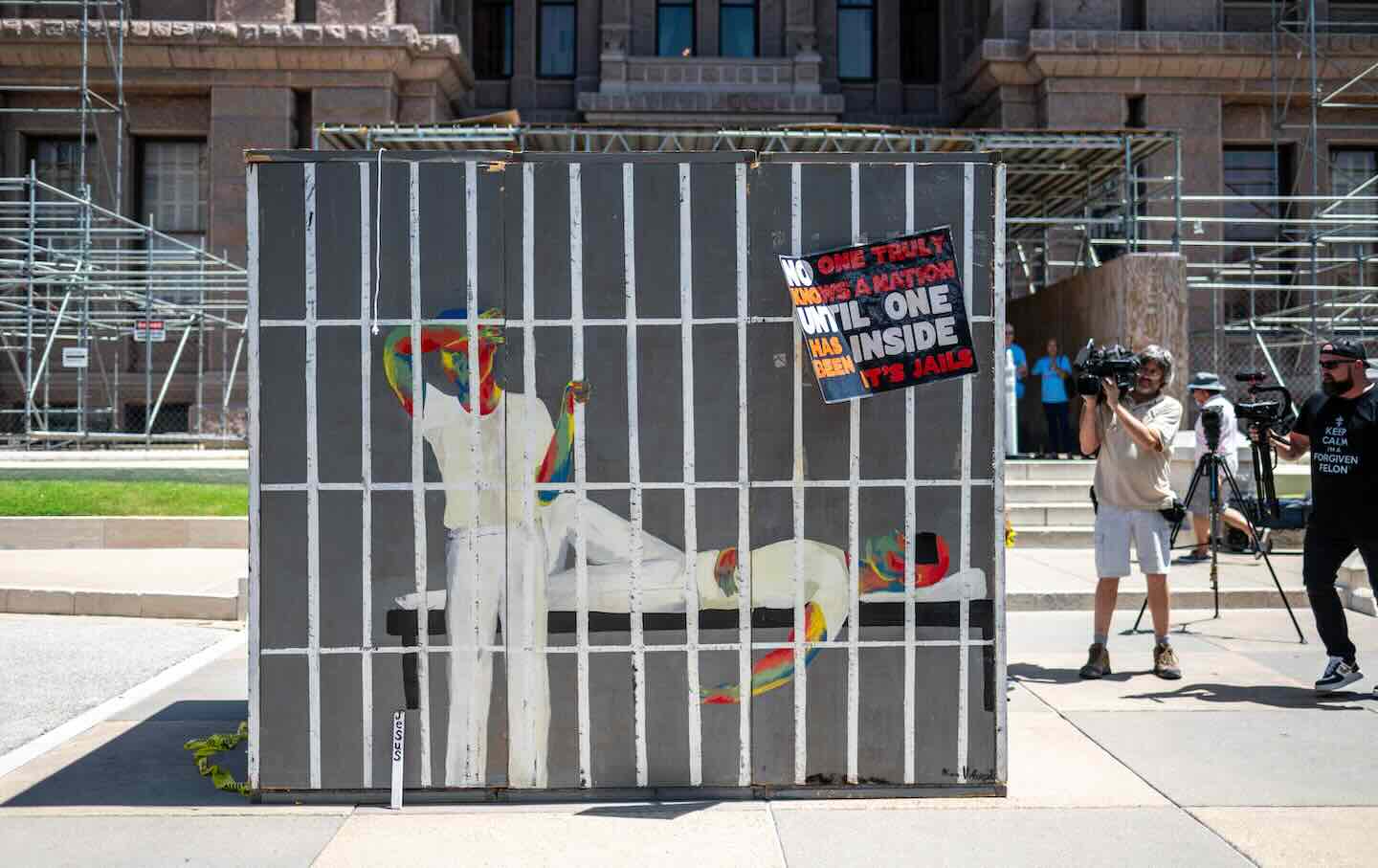
[ad_1]
Politics
/
August 28, 2024
From district courts all the way up to the Supreme Court, judges are refusing to retire, holding on to power well past their prime.

Judge using gavel in court (focus on foreground, blurred motion)—stock photo
(Kelvin Murray / Getty Images)
An excellent report from NBC News highlights a serious problem with our federal judiciary: Its members are aging, and those that have been there longest don’t want to give up power.
There are currently 870 active federal judges, and 104 of them are eligible to retire, but refuse to do so. That means that 12 percent of the judiciary is over 65, has been in power for at least a decade and a half, yet refuses to move on. According to the report, 14 of those judges are older than Joe Biden, and that is interesting given that Biden just treated the country to such a master class in torch passing that they’ll probably try to copy it in the 2030 Olympics.
While Biden succumbed to intense public outcry to abandon his attempt to secure another term in office, federal judges with the power to block Biden’s (or anybody else’s) agenda face almost no public pressure to relinquish power, clear space for the next generation, or even prove that they are still cognitively able to do their jobs at the highest level.
The stubborn refusal of federal judges to cede power is one reason term limits are so popular with the American public. A recent poll showed that 70 percent of adults supported putting limits on judges’ time in office—and those adults even include Republicans; according to the data, a solid 56 percent of them support the idea.
Last month, President Biden made news when he proposed setting an 18-year term limit on Supreme Court justices, and that proposal was quickly endorsed by Vice President Kamala Harris and the Democratic Party more broadly. The idea is to stagger those terms, meaning that one person on the nine-member Supreme Court would be term-limited out every two years.
Despite their popularity, there are constitutional problems with term limits. I’ve laid them all out in the past, but briefly put: The Constitution says that federal judges serve for life and, absent impeachment, there’s no obvious way to force out a Supreme Court justice who wishes to hang on to their job until they slip this mortal coil. Still, there is a potential work-around to authorize term limits without a constitutional amendment. While the Constitution says that federal judges serve for life, it doesn’t say where in the federal judiciary they must serve.
Current Issue

The solution to make term limits constitutional has already been tried on other federal courts. It’s called “senior status” and it’s a form of semiretirement offered to federal judges who have reached the age of 65 and served at least 15 years on the bench. They retain their full salary (as required by the Constitution) and can continue to sit on their circuit court and participate in cases. But their “seat” on the circuit opens up, and the president can appoint—and Congress confirm—a new judge to fill their slot. Senior status limits the lifetime power of federal judges, without violating any constitutional principle.
The problem with senior status, as the NBC report shows, is that it is voluntary. Federal judges are not forced into semiretirement but merely given the option. And when we look at how that optional choice plays out on the lower courts, it’s pretty clear that it’s not working. If the Democrats under a Harris administration are going to push forward term limits for the Supreme Court, they might as well reform the senior-status process on the lower courts as well.
Of the 104 judges who could enter into semiretirement, 78 were appointed by Republican presidents. Frankly, I can’t criticize these people too much, because, like Republicans, I understand the strategic importance of timing when it comes to judicial retirements. In our current system, it’s functional malpractice to retire under the administration of the opposite party. While judges like to claim they’re above partisanship—and are loyal only to the law—the reality is that there are Democratic judges, and there are Republican judges, and most of them do everything they can to retire or take senior status under an administration that shares their values.
If anything, the Republican judges who’ve refused to retire under Biden are just underscoring how politicized the entire federal judiciary has become—and how desperately the system is in need of reform. A judge’s best, most politically responsible option should not be to hang on into their 70s or 80s just waiting for the right administration to appoint their replacement.
As for the 26 judges appointed by Democratic presidents who have refused to retire under Biden… I have nothing but the harshest criticism. Biden’s judicial appointments have been astounding, for the most part. His judges have been impeccably qualified, diverse, and have come from all different backgrounds in terms of education and experience. And both Senate majority leader Chuck Schumer and Senate Judiciary chairman Dick Durbin have been effective at getting Biden’s nominees across the finish line to confirmation. There is simply no good reason for a Democratic judge to hang on, other than their ego and outsize sense of self-importance.
The point of term limits (and forced semi-retirements) is not just to cut the lifetime power of federal judges. The point is to take the balance of partisan power in the federal judiciary out of the hands of folks who can’t think of anything better to do in their golden years—and put the power back where it belongs, in the hands of voters. A system with staggered terms leads to regular, planned judicial appointments. It takes “strategic” retirements out of the mix and guarantees that every president has the opportunity to appoint a set number of judges. Over time, this would mean that the judiciary would reflect which party wins elections, instead of reflecting which judges were smart enough to retire at the opportune moment.
Critics of term limits, including Senate minority leader Mitch McConnell—yet another octogenarian who won’t go fishing like a normal old person—have said that term limits threaten “judicial independence.” Their theory is that term limits will create a situation in which judges are so concerned about their next job that they will make rulings designed to set themselves up with lucrative gigs once their time on the bench is through.
Ad Policy
McConnell’s argument, however, fails at almost every level. First of all, we’re talking about senior status, which means that judges retain their full salary. Now, I appreciate that some judges don’t think they’re being paid enough, and some judges have found corrupt ways to supplement their income, but the potential lure of the next big-money job is no different for active judges than it is for senior judges. Every single member of the federal judiciary could double (at least) their salary at a law firm of their choosing. No judge, except perhaps Clarence Thomas, is in it for the money.
Moreover, the kinds of jobs that most retired federal judges are likely to want and get are not exactly the jobs that lead to corrupt judicial decision-making. I simply do not think a judge would think, “Well, I can’t rule the way I want to in this case because I might not be able to be a law professor in 18 years.”
Finally, we are talking about people who have reached the age most Americans retire if they’re lucky enough to be able to afford to retire. If McConnell really thinks the threat of impending retirement is so financially compromising as to cause a person to make corrupt deals while they still have a job, perhaps McConnell should join the Democrats and invest more money and resources in Social Security.
Popular
“swipe left below to view more authors”Swipe →
I’m not sure how to make term limits constitutional from the perspective of the justices on the Supreme Court who would have to approve this limitation to their lifetime power. But if we’re somehow going to apply term limits to the Supreme Court, we should also apply them to the entire federal judiciary. The current senior-status system isn’t really working, as it’s leaving too much power in the hands of people who are too selfish to make way for the next generation of judges.
The grim reaper is slowly loosening the iron grip of the baby boomer gerontocracy. The time to reform our system so we don’t repeat our mistakes is now.
I don’t know what will happen to my reformer instincts when I am 70 years old, but I can only assume, based on the evidence of my elders, that I will come to view keeping my job as somehow critical to the proper functioning of society. I will be wrong, but good luck convincing me of that. When I too lose the plot, I hope somebody allows me to keep my full salary while they gently ease me off to the side to make way for the future.
Can we count on you?
In the coming election, the fate of our democracy and fundamental civil rights are on the ballot. The conservative architects of Project 2025 are scheming to institutionalize Donald Trump’s authoritarian vision across all levels of government if he should win.
We’ve already seen events that fill us with both dread and cautious optimism—throughout it all, The Nation has been a bulwark against misinformation and an advocate for bold, principled perspectives. Our dedicated writers have sat down with Kamala Harris and Bernie Sanders for interviews, unpacked the shallow right-wing populist appeals of J.D. Vance, and debated the pathway for a Democratic victory in November.
Stories like these and the one you just read are vital at this critical juncture in our country’s history. Now more than ever, we need clear-eyed and deeply reported independent journalism to make sense of the headlines and sort fact from fiction. Donate today and join our 160-year legacy of speaking truth to power and uplifting the voices of grassroots advocates.
Throughout 2024 and what is likely the defining election of our lifetimes, we need your support to continue publishing the insightful journalism you rely on.
Thank you,
The Editors of The Nation
Elie Mystal
Elie Mystal is The Nation’s justice correspondent and the host of its legal podcast, Contempt of Court. He is also an Alfred Knobler Fellow at the Type Media Center. His first book is the New York Times bestseller Allow Me to Retort: A Black Guy’s Guide to the Constitution, published by The New Press. Elie can be followed @ElieNYC.
More from The Nation

Despite claiming to support AI safety, powerful tech interests are trying to kill SB1047.
Lawrence Lessig

Extreme heat has long been a concern for incarcerated pregnant women and those behind bars with underlying health conditions.
Victoria Law
![On Feb. 27, 2013, just a few hours after Solicitor General Donald Verrilli endeavored to protect the Voting Rights Act before the U.S. Supreme Court, he dropped by his boss’s office and told US Attorney General Eric Holder that arguments in the case, Shelby County v. Holder, had gone poorly. Verrilli warned Holder things might be worse than they feared: The Court intended to go after the entirety of preclearance, the VRA’s most crucial enforcement mechanism. Holder scarcely believed that could be possible. “The Voting Rights Act? Come on,” Holder said. But to the veteran solicitor general, recovering from the most brutal experience he’d ever had before the Court, the writing was on the wall. “I walked out of that courtroom certain that’s what was going to happen,” Verrilli told me. “I was never optimistic at all.” Verrilli had underestimated how meticulously John Roberts had planned for this moment. He never imagined that he’d be hit with such mendacious numbers and arguments in a sanctum he revered. And though his pessimism turned out to be abundantly justified, the dishonest reasoning behind Roberts’s decision – that the chief justice could just conjure a doctrine of his own creation and use it to eviscerate the most important civil rights legislation in the nation’s history – haunts the solicitor general to this day. It has remade American democracy as well. [dropcap]J[/dropcap]ohn Roberts had schemed for decades prior to this moment. Three years earlier, a test case known as Northwest Austin allowed Roberts to carefully plant the seeds for the challenge that foes of voting rights law mounted in Shelby County. A tiny municipal water board in a new Texas development posed a large constitutional question. The VRA’s preclearance regime required every locality in the state to -approve in advance any changes to voting procedures through the Department of Justice. Preclearance worked to right historical wrongs: The VRA mandated it in the handful of states and localities with the worst records of racial discrimination in elections; when Congress reauthorized the Voting Rights Act by near-unanimous margins in 2006, it relied on a record of ongoing modern chicanery stretching toward 14,000 pages, bearing eloquent testimony to the ongoing need for preclearance. Two lower federal courts had agreed that the utility district did not qualify for exemption from the VRA, and that preclearance itself remained a proportionate response by Congress. “The racial disparities revealed in the 2006 legislative record differ little from what Congress found in 1975,” wrote federal appeals Judge David Tatel. “In view of this extensive legislative record and the deference we owe Congress, we see no constitutional basis for rejecting Congress’s considered judgment.” Before Tatel wrote his decision, he read every page of the 2006 congressional report, and tracked the stories of canceled elections and last-second precinct switches across Mississippi, Louisiana and other covered states. He did so, he told me, because “I had no confidence that the Supreme Court would ever look at the record.” His fears were justified. On April 29, 2006, during the oral arguments over Northwest Austin, Roberts expressed impatience, and sounded as if he simply didn’t believe these challenges continued. “Well, that’s like the old elephant whistle. You know, I have this whistle to keep away the elephants,” he said, dismissively, as the defense pointed out the ongoing need for preclearance in the case. “There are no elephants, so it must work. “Obviously no one doubts the history here,” he added. “But at what point does that history stop justifying action with respect to some jurisdictions but not with respect to others . . . . When do they have to stop?” Neal Kaytal, then the principal deputy solicitor general, responded that since Congress had reauthorized the VRA for another 25 years, that date would be 2031. Roberts was unimpressed. “I mean, at some point it begins to look like the idea is that this is going to go on forever.” The court’s five conservatives wanted to move on, and several appeared ready to address the larger constitutional issues that would trigger a challenge the VRA, but didn’t have much beyond vibes to go on. So Roberts brokered a deal, and wrote an apparently unifying decision for a court that appeared deeply divided during oral arguments. Everybody won, sort of. The water district would be allowed to bail out of preclearance requirements. Other small entities were invited to apply for a reprieve. At the same time section 5—laying out the VRA’s preclearance regime— survived. The liberal justices bought time for Congress to potentially address the court’s impatience with the preclearance formula once more. “It wasn’t exactly a principled constitutional decision,” says Tatel, who had scoured the law to see if he could deliver a similar ruling that sanctioned a bailout for the water district, in part to keep the VRA away from the high court. But the law clearly didn’t allow it. (“It doesn’t work with the law. It’s not right,” he told me, “but that didn’t bother the court.”) “They made a deal,” says Edward Blum, who helped bring the challenge to the VRA, and would also mastermind the clutch of cases that led the court to end affirmative action in college admissions. Roberts seemed to have done the impossible, and he won praise from the media and court watchers for his measured and far-seeing “judicial statesmanship.” Liberals even claimed victory, crowing to The New Republic that they prevented the VRA from being struck down 5-4 by threatening some thunderous dissent that either led Justice Kennedy to get cold feet or the chief justice to back down. If the liberals wanted to celebrate an imaginary win, Roberts had no problem with that. The chief justice was busy digging a trench and setting a trap. Indeed, the liberal justices scarcely seemed to notice the actual language of the opinion that they signed onto. “Things have changed in the South,” Roberts declared, writing for the full court. The VRA, he wrote, “imposes current burdens and must be justified by current needs.” Roberts had conned the liberals into signing onto a broad indictment of the reasoning behind preclearance, aimed at a future case and a future decision. “The statute’s coverage formula is based on data that is now more than 35 years old,” Roberts argued, as though civil-right legislation had a sell-by date. “And there is considerable evidence that it fails to account for current political conditions.” Then Roberts made one additional stealth play that helped assure that the next challenge to the VRA would arise quickly and would be aided by the plaintiffs’ success in Northwest Austin. He made an observation known as dicta—a comment that might not be necessary to resolve a case or even be legally binding in the future, but that can be cited as a “persuasive authority.” This is where Roberts gave birth to the fiction of a “fundamental principle of equal sovereignty” among states. The trouble with the principle is that it does not exist. Roberts created it with an ellipsis and what can only be understood as deliberate misapplication of the law. Indeed, the Supreme Court had rejected this precise reading in a 1966 voting rights case that upheld the Act’s constitutionality, in the very sentence that Roberts later claimed said the opposite. How did he get away with turning up into down? He cut the clauses he didn’t like and called it law. Here is the actual decision from the case in question, Katzenbach v South Carolina: In acceptable legislative fashion, Congress chose to limit its attention to the geographic areas where immediate action seemed necessary . . . . The doctrine of the equality of States, invoked by South Carolina, does not bar this approach, for that doctrine applies only to the terms upon which States are admitted to the Union, and not to the remedies for local evils which have subsequently appeared. And here is what Roberts wrote: The Act also differentiates between the States, despite our historic tradition that all the States enjoy “equal sovereignty.” Distinctions can be justified in some cases. “The doctrine of the equality of States … does not bar … remedies for local evils which have subsequently appeared.” But a departure from the fundamental principle of equal sovereignty requires a showing that a statute’s disparate geographic coverage is sufficiently related to the problem that it targets. Before Roberts wrote this, there was no such principle—let alone a fundamental one. The cases that Roberts cites as authorities for the idea of equality among states actually concern the “equal footing doctrine,” which secures equality among newly admitted states. No fundamental principle of equality among states governs the Fifteenth Amendment, which explicitly hands Congress the power to enact appropriate legislation to ensure equal treatment of all voters within states. Liberal justices either didn’t notice the dicta or did not think that Roberts would be so brazen as to write it into law citing his own invented precedent the next time a preclearance case came before the court. They underestimated both his chutzpah and hubris. It would not be the first, or the last time. [dropcap]I[/dropcap]f Roberts weakened the VRA’s foundations in Northwest Austin, four years later, in Shelby County, he came with the bulldozer. The preclearance formula had become outdated and no longer considered “current conditions,” Roberts wrote, brushing aside the lengthy congressional record filled with modern-day examples. Singling out states for disparate treatment, he held, failed to accord each state its “equal sovereignty.” The decision appeared modest and suggested that the Court had little choice but to act. But the feigned modesty was pure misdirection. The Shelby County decision is a deeply radical one. It usurps powers the Constitution specifically awards Congress. It uses the fictional principle of equal sovereignty, cooked up by Roberts in 2009, as its basis. And it cites statistics that are factually wrong and misstate the U.S. census. In the wake of other draconian hard-right decisions, such Dobbs v. Jackson Women’s Health (2022), reversing the right to abortion, and Loper Bright Enterprises v. Raimondo (2024), striking down “chevron deference” and effectively undermining the authority of federal regulatory agencies, public confidence in the high court has plummeted. Large majorities of Americans see the justices as partisan proxies, viewing the law through whatever lens might create victories for their side. But even this disillusioned American majority may not suspect that the justices might just be making the law up as they go along—that their opinions carry footnotes and the force of law but stand on air. Nor do most Americans fully appreciate that five, and now six, of them can get away with this because they form a majority ideological bloc, accountable to no one. That’s the real story behind John Roberts’s opinion in Shelby County. The chief justice obliterated the most successful civil rights legislation this nation has ever seen not just on flimsy criteria but on none at all. “It’s made up,” the conservative judge and law professor Michael McConnell, a George W. Bush appointee, told NPR. “This is a principle of constitutional law of which I had never heard,” the conservative judge and legal scholar Richard Posner observed, “for the excellent reason that … there is no such principle.” “Yes, that’s right,” says Leah Litman, a law professor at the University of Michigan. “There are passing references to the idea of equal sovereignty. But if you pause and think about them for more than a second, it’s clear that [Roberts] made the doctrine into something that it just wasn’t.” Litman is the national authority on equal sovereignty. In 2016, she wrote a complete 67-page history of what Roberts called a “fundamental principle” and “historic tradition.” Her conclusion? Roberts manufactured it for his own purposes. It is, she writes, an “invented tradition”---invented by John Roberts, and then cited by John Roberts. What Roberts didn’t make up, he got wrong. Roberts based his reasoning that things had changed in the South on voter registration statistics that, to him, showed that Blacks and whites had reached something close to parity—and that in some states, Blacks had even surpassed whites. His opinion even included a chart ostensibly documenting this. In reality, though, Roberts had the statistics backward. They did not show what he said they did. In many cases, they showed the opposite. Roberts used the numbers from the Senate Judiciary Report—the one that Republicans generated after the VRA’s passage to plant a record for its judicial demise. And intentionally or otherwise, the GOP report got it wrong. Roberts and the committee overstated white registration numbers. The Roberts chart counted Hispanics as whites—even those who were not U.S. citizens and therefore ineligible to vote. That basic error threw off all the demographic comparisons. In Georgia, for example, Roberts claimed that Black registration had risen to 64.2 percent and white registration had fallen behind at 63.5. But without the Hispanic numbers, white registration grew to 68 percent. It’s an improvement from 1965. But it’s not an example of Black registration outpacing whites, as Roberts claimed. In Virginia, meanwhile, Roberts argued that the gap between whites and Blacks had narrowed to just 10 percent—when in reality, it was more than 14 percent. Roberts simply didn’t understand how the census reported race. The Bureau treats race and ethnicity differently. Hispanics are counted as an ethnicity, then usually included under white. The chief justice should have used the data for white-non-Hispanic. But that would not have given Roberts the result he wanted. When reporters asked the court to explain how he could have gotten something so basic so wrong, the chief justice declined to answer questions. The court “does not comment on its opinions,” said a spokesperson, “which speak for themselves.” [dropcap]“T[/dropcap]his was Congress’s decision to make,” solicitor general Verrilli told me—a power awarded explicitly by the Reconstruction amendments to the Constitution. Debo Adegbile, who defended the VRA before the court during both Shelby County and Northwest Austin, sees the long throughline of the Court’s resistance to the full sweep of those amendments. The court’s impatience with the past, its eagerness to declare the job complete and the nation whole, reminded him of the 1870s Cruikshank and Civil Rights Cases decisions that choked off Reconstruction and insisted Blacks must “cease to be the special favorites of the law” even as freed slaves carried scars of their bondage. “It’s just the continued resistance to the commitment to make the country whole and to be an inclusive democracy,” he told me. “And it’s being dressed up in sophisticated legal arguments. It’s not that we’re actually past anything. It’s that we are now at a point where we have the power to decide that we’re going to vary from the mission, create a situation where voters are exposed and . . . advantage the manipulations of state actors and local actors to impose barriers.” Holder still stammers in disbelief. “Okay, Mr. Chief Justice, you say that America has changed. OK. And what’s your basis for saying that, as opposed to Congress holding hearings, thousands of pages of testimony, hundreds of exhibits that say America has changed some, but not enough? You’re saying, ‘No, Congress, essentially you’re wrong.’ . . . OK. Then where were your researchers?” The former attorney general winces in horror when the case is referred to by its full name: Shelby County v Holder. He cites two days as the worst of his tenure: The day he accompanied President Barack Obama to console parents of children slain during the Sandy Hook massacre, and “the other one was to hear from the Supreme Court that the Voting Rights Act of 1965 was, in substantial ways, murdered.” “Nothing had changed in the South,” he told me. “The only thing that changed was the personnel on the U.S. Supreme Court.” Verrilli also replays this crushing defeat in his head, wondering if there was anything he could have done to guard the Voting Rights Act against implacable foes. “I wish I could tell you, David, that I have stopped doing that, but I have not. It haunts me to this day.” He slows and wipes his eyes. It’s clear he is fighting back tears, unsuccessfully. “I think all the time about what I might have done differently, because it was a devastating defeat and it had huge consequences. I take solace in the thought that I don’t think there’s anything I could have done differently. But that only makes it marginally less powerful.” Adapted from Antidemoccratic: Inside the Far Right’s 50-Year Plot to Control American Elections by David Daley, Mariner Books, 2024. All rights reserved](https://www.thenation.com/wp-content/uploads/2024/08/RobertCrop.jpg)
On February 27, 2013, just a few hours after Solicitor General Donald Verrilli endeavored to protect the Voting Rights Act before the US Supreme Court, he dropped by his boss’s off…
David Daley

These are some concrete steps a President Harris could take to undo the damage of her current boss.
Gregg Gonsalves

As always, the DNC was an endurance grind. But my serendipitous encounter with a woman who embodies Harris’s reproductive justice agenda was the high point for me.
Joan Walsh
[ad_2]